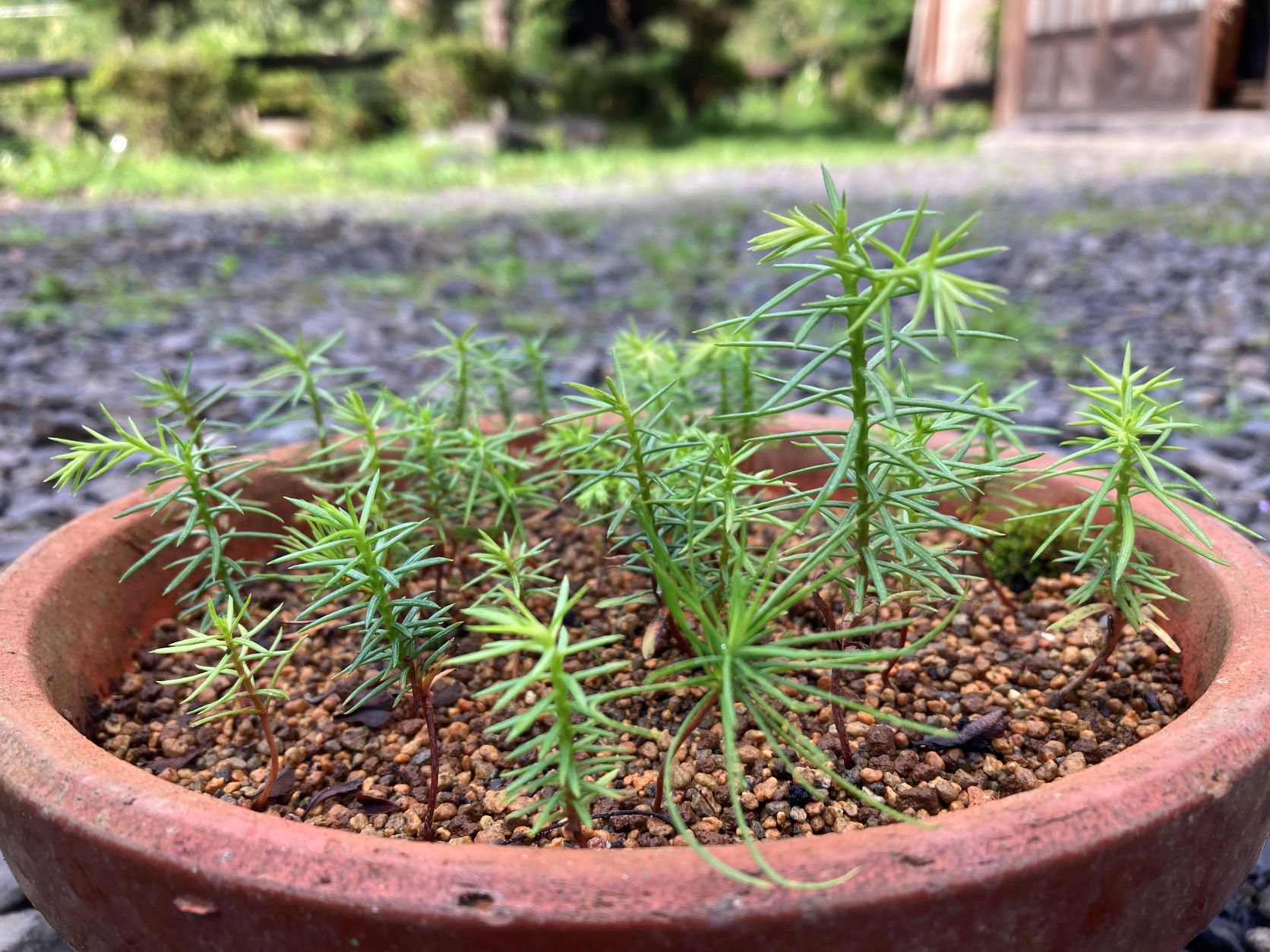The soil, temperature, and moisture are all key factors in successful germination, but they also can create problems as the seed grows if they are not properly controlled.
The main factors causing common baby bonsai problems such as not growing, leaves turning yellow/brown, dropping, wilting and dying are too much/little sunlight/water, low temperature, fertilizer burn, diseases or inappropriate soil type.
Baby bonsai turning yellow/brown
The main causes of baby bonsai turning yellow/brown are as follows.
- Lack of sunlight / too much sunlight
- Lack of water/ too much water
- Inadequate temperature/ sudden temperature change
- Too much fertilizer
- Pests and diseases
- Inappropriate soil (pH, drainage)
Lack of sunlight / too much sunlight

Lack of sunlight
Light is critical for plant growth after germination. Seed leaves (cotyledons) will be an energy source for a while after germination. After they have fallen off, a baby bonsai needs sunlight to create energy for itself through photosynthesis. Without enough sunlight, the seedlings will become tall and leggy and leaves turn yellow/brown.
If you are growing a baby bonsai indoors, even a south-facing window may not provide enough light for good growth. The exact amount of light depends on the bonsai species but most of them are photophilic (sunlight-loving) plants and they need direct sun exposure to thrive.
Too much sunlight
On the other hand, too much sunlight can be problematic for your baby bonsai as well. Seedlings are still fragile with an underdeveloped root system and only a few leaves for photosynthesis.
Direct exposure to the strong afternoon sun, especially in midsummer, can significantly weaken the growth and may cause leaf scorch and root rot. Without some kind of protection like a shade from strong sunlight, the leaves may burn and turn yellow/brown
Lack of water / too much water

Moisture, either too little or too much, can be a real killer to a baby bonsai.
Lack of water
As a baby bonsai, the root system only began to form itself and is yet to be fully developed. Lack of water, even for a short period of time, can be detrimental to a baby bonsai at this stage, especially for species intolerant to drought.
Rapid dehydration often causes the leaves to turn yellow/reddish-brown at the edges with a distinct delineation between live and dead tissue.
Too much water
Too much moisture in the soil from overwatering is also stressful to a baby bonsai. Roots need oxygen to burn carbohydrates for their energy to grow and repair. During root respiration, plant roots use glucose made by photosynthesis for their various functions, like nutrient uptake and maintaining and growing their tissues.
The roots will drown if the soil is too wet to respirate, resulting in root rot. The edges of your baby bonsai leaves will turn yellow at the beginning stage and then brown if the soil is still kept moist.
Inadequate temperature / sudden temperature changes
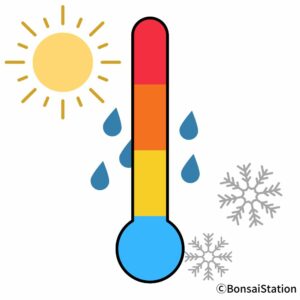
Inadequate temperature
Temperature influences most plant processes such as photosynthesis, transpiration, and respiration. Each species have a certain range of temperatures at which they can grow soundly.
At low temperatures, baby bonsai cannot grow. Temperature below the favorable range can decrease photosynthesis, causing a disruption in energy creation and nutrient intake. The leaves start to turn yellow as they are too slow to produce chlorophyll (green pigment).
High temperature, even for short period, also negatively affects a baby bonsai as well. Air temperature beyond an adequate level reduces the growth of new shoots and in turn reduces root growth. High temperature lead to dehydration and leaves are scorched.
High soil temperature is more crucial as damage to the roots is severe, resulting in a substantial reduction in shoot growth. High soil temperature can be caused when a baby bonsai is planted in a small black plastic pot and kept outdoors under strong sunlight.
Sudden temperature change
Baby bonsai can be stressed due to a sudden change in temperature, high or low. Plants have the ability to cool off through evaporation and warm up through irradiance. But a baby bonsai has yet to use this ability. They have narrower temperature limits and a sudden change in temperature is damaging.
Too much fertilizer
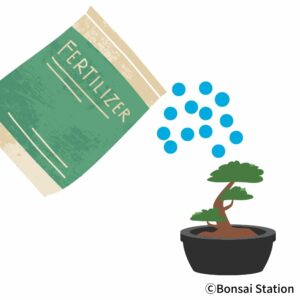
Seedlings do not need fertilizer from sowing through the first weeks after germination because the cotyledons (baby leaves), which are formed inside the seed, have all the initial nutrition they need to sustain seedling growth. Seedlings should be fertilized after baby leaves are fallen and two to three sets of leaves sprout beside baby leaves.
Even after new leaves have come out, baby bonsai, especially coniferous/pines, do not need lots of fertilizers. Plants need developed roots to take up nutrients from the soil, which seedlings do not have yet. Overboarding baby bonsai with fertilizers may lead to root rot due to fertilizer burn.
Pests and diseases
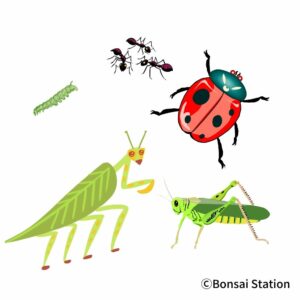
Pests and diseases may be behind seedlings turning yellow. The combination of too much moisture in the soil and a warm temperature creates ideal conditions for fungal diseases. This is made worse if non-sterile/recycled soil is used.
Inappropriate soil (pH, drainage)
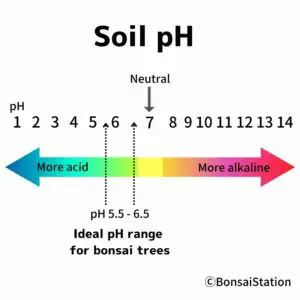
Soil pH & bonsai tree
A baby bonsai leaves may turn yellow/brown if they are planted in inappropriate soil.
Most of the bonsai species are acid-loving plants and soils with a pH between 5.5 to 6.5 generally provide the best growing conditions. Usually, germination soil you can get at gardening shops fit within this range but it may not if you mix your own soil.
Drainage of the soil is important, especially for coniferous baby bonsai trees. They can only thrive in well-drained sandy/rocky soil. Normal potting soil is too compacted and keeps too much moisture for these trees.
Baby bonsai dropping

Baby bonsai leaves dropping may be caused by watering problem (too little/too much water) or fertilizer burn. Excessive water is a common result of growing a seedling in a large pot because it does not absorb much moisture and the soil in the pot stays always soggy.
Giving a baby bonsai too much fertilizer may be the cause of dropping leaves because it may cause fertilizer burn to its undeveloped root system.
Baby bonsai not growing
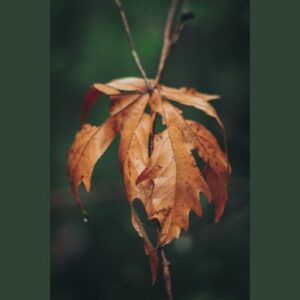
After successfully germinating, bonsai seedlings sometimes stop growing. This can be caused by low temperature, overcrowding in the pot or outgrowing the pot.
Low temperature
Seedlings need warmth and may stop growing if the temperature is not warm enough after germination. Temperature is one of the most important variables that influence plant growth and 68F (20°C) is found to be ideal with some range on the upper side.
Overcrowding in the pot
Overcrowding or too small of a pot can cause roots to run out of space and halt growth. If you have quite a few baby bonsai in a small pot, they cannot grow (or grow very slowly) because there are not enough resources to go around.
Outgrowing the pot
Even if your baby bonsai is in its own pot with a good soil mix, it may stop growing if it has outgrown the pot. A root-bound tree cannot absorb water or nutrients for it to grow.
Bany bonsai wilting

The major cause of your baby bonsai wilting is lack of water or too much water.
Seedlings wilt when roots are unable to supply sufficient moisture to the stems and leaves. As baby bonsai’s root system is not fully developed, wilting can happen very quickly when they lack water. Rapid dehydration causes the leaves to turn reddish-brown at the edges with a distinct delineation between live and dead tissue. If serious enough, leaf drop may occur or the whole plant may die.
In the same way, too much water can also cause wilting. Overwatering or roots growing in poorly drained soils can quickly become deprived of oxygen, leading to wilting and yellowing, and browning of leaves and stems.
Baby bonsai dying
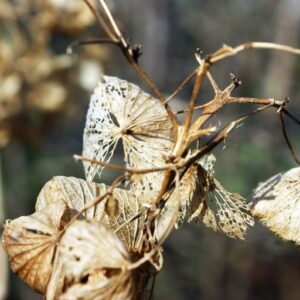
Your baby bonsai may be dying if you keep the following problems untreated.
- Lack of sunlight / too much sunlight
- Lack of water/ too much water
- Inadequate temperature/ sudden temperature change
- Too much fertilizer
- Pests and diseases
- Inappropriate soil (pH, drainage)
Baby bonsai trees, especially less than a year old ones, are not strong enough and do not have much room to tolerate a harsh environment.

